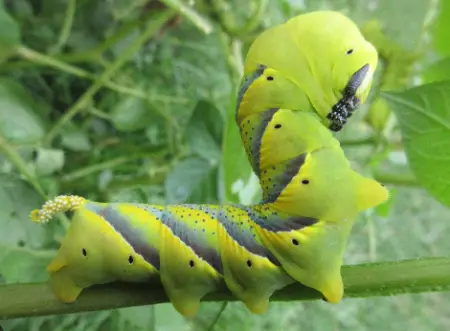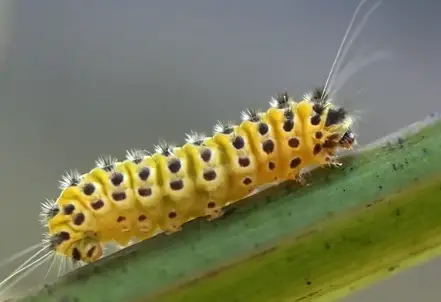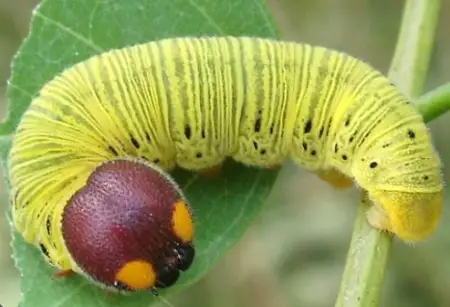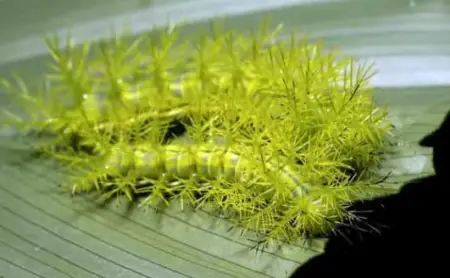You probably have come across different types of yellow caterpillars. Some might have fuzzy appearance and others smooth segmented bodies. The yellow fuzzy caterpillars are poisonous, though the toxin will not kill you.
The yellow woolly bear and sycamore moth caterpillars are the venomous species. The toxin can kill small birds and rodents if ingested in large quantities. This guide provides descriptions and pictures of various yellow caterpillars for easy identification.
Are Yellow Caterpillars Poisonous?
Most yellow caterpillars have spiky hairs connected to poisonous glands. The channels in the spines transmit venom that causes skin irritation after coming into contact.
Refrain from touching or handling yellow caterpillars in your garden or yard to avoid irritating the skin. Burning sensation and rashes are the symptoms caterpillar stings.
If you pet or toddler is stung by a yellow caterpillar, we recommend seeking medical assistance from a professional. Most home remedies will not be effective in treating.
Schedule a routine of spraying your yard or garden with insecticides when you notice caterpillar infestation. You can also invite birds into the yard or garden to eat them.
Caterpillars can defoliate your backyard ornamental trees and crops. Controlling the infestation of moth and butterfly caterpillars will help safeguard them. (Source: BNA).
Different Types of Yellow Caterpillars
The yellow caterpillars are easy to recognize them due to the yellow coloring. Here is a detailed list of yellow caterpillars with names and pictures:
Zebra Caterpillar

Zebra caterpillars are native to the Northeastern United States of America. These caterpillars feed in colonies and are prevalent in August.
They have multicolored body with yellow color being conspicuous. The black and yellow stripes with fine white lines are the distinctive features.
The zebra caterpillars also have red rounded head and can grow up to 2 inches long. Be sure to refrain from handling these caterpillars despite being harmless.
Scientific Name |
Melanchra picta |
Host Plants |
Cabbages, beets and other crops |
Identification Features |
Black and yellow stripes with fine white lines. Rounded reddish-brown head and underside. |
Buff-Tip Moth Caterpillar

It is a fuzzy yellow caterpillar with a slender body often seen between the month of July and October. The black and yellow bands around the black body are distinctive features.
The fine hair covering the body can cause skin irritation and burning sensation upon rubbing on a human skin. Refrain from handling these caterpillars with protective gear.
Buff-tip moth caterpillars grow up to 50mm long and feed on oak, willow, birch, poplar, and alder leaves. Use chemical treatments to kill these grubs from your backyard trees.
Scientific Name |
Phalera bucephala |
Host Plants |
Oak, birch, willow, poplar, and alder |
Identification Features |
Yellow and black bands with fine hairs covering the black body. |
Mullein Moth Caterpillar

It is a pale-grey caterpillar with conspicuous yellow and black spots. The bright yellow patterns are distinctive for easy recognition.
Other features for identifying Mullein moth caterpillars are black head, prolegs, front legs, and fine setae. The cylindrical body-shaped caterpillar grows up to 44-48mm long.
Scientific Name |
Cucullia verbasci |
Host Plants |
Figwort |
Identification Features |
Black and yellow patterns on a pale-blue to grey body. |
Tomato Moth Caterpillar

The slug-like insect has a yellowish-tan to dark greenish-brown body. The small white and black dots with dark faint lines running lengthwise are the distinctive features.
Some tomato moth caterpillar species have conspicuous yellow stripes along their sides with deep brown body. These caterpillars are not considered as garden pests.
Tomato moth caterpillars feed on dandelion, plantain, dock and water mint. But they become dangerous when infesting greenhouse tomatoes and fruits.
Scientific Name |
Lacanobia oleracea |
Host Plants |
Greenhouse tomatoes and other cultivated crops. |
Identification Features |
Cylindrical body with yellowish-tan to dark greenish-brown color. |
Marbled Yellow Pearl Moth Caterpillar

It is a brightly colored caterpillar with rows of black dots along the back and yellow body. Other conspicuous colors visible are pale-grey, white, and orange stripes.
The fine black spiny hairs can cause skin irritation and rashes when they come into contact with human skin. Always refrain from handling these caterpillars by all means.
These striped yellow caterpillars turn into attractive moths with pale whitish-gray and brow wings. These beautiful wings also have brown dots and pale orange markings.
Scientific Name |
Evergestis extimalis |
Host Plants |
Cruciferous plants |
Identification Features |
Bright yellow color with orange, pale-gray, and white longitudinal stripes. It also has a line of black dots on the black. |
Magpie Moth Caterpillar

It is a pale-yellow caterpillar with rows of black and white dots, and yellow stripes along its body. These distinctive features are ideal for easy recognition during classification.
Other prominent features are white markings, black head and legs. Refrain from touching these grubs since the fine setae can cause skin irritation and inflammation.
Magpie moth caterpillars have long and slender bodies and feed on deciduous trees or shrubs. They are often seen between the month of April and May.
Scientific Name |
Abraxas grossulariata |
Host Plants |
Berry shrubs |
Identification Features |
Creamy yellowish-white body with rows of black and white dots. |
Grass Eggar Moth Caterpillar

It is a black moth caterpillar with heavy-coating of pale-yellow to orange brown hairs on its body. The hairy caterpillar comes in different color shades depending on species.
The orange bands along the sides and yellow hairs are the distinctive features. These grubs feed on the leaves of oak, willow, and birch trees.
They also feed on various types of grasses and can grow up to 65mm long. The stinging hairs make these caterpillars dangerous to handle.
Scientific Name |
Lasiocampa trifolii |
Host Plants |
Oak, willow, and birch trees |
Identification Features |
Yellow hairs on a black body with orange bands along its sides. |
Large Cabbage White Caterpillar

It is a dark yellow caterpillar with black spots and fine setae. The distinctive brown head and black tubercles are ideal for easy recognition.
These caterpillars keep changing their colors in each instar. Mature caterpillars are dark grayish green and black before pupation.
The large cabbage white caterpillar grows up to 40mm long and also called cabbage worms. These long slug-like insects can cause complete crop loss in the summer.
Scientific Name |
Pieris brassicae |
Host Plants |
Cabbages and other cultivated crops |
Identification Features |
Yellowish-green body with black spots and white spiny setae. |
African Death’s-Head Hawkmoth

It is a giant bright yellow caterpillar that resembles a yellow tobacco hornworm. The diagonal grayish stripes along the golden yellow body are the distinctive features.
The black speckles on the back and six tiny legs on the head are other features for easy recognition. Other caterpillar species have horns curling round and point upwards.
The smooth and glossy caterpillar is harmless to humans and can grow up to 150mm long. These grubs feed on the leaves of potatoes, olive trees, and hemp plants.
Scientific Name |
Acherontia Atropos |
Host Plants |
Potatoes, olive trees, and hemp plants |
Identification Features |
Giant bright yellow body with diagonal grayish stripes and spotted back. |
White-Lined Sphinx Moth Caterpillar

The moth caterpillar comes in different color variations depending on the species. The yellowish-green to dark yellow are the prominent colors.
These caterpillars also have conspicuous two black stripes running lengthwise along their bodies. Orange tail, brown head, and brown spots are other distinctive features.
Some species have lime-green bodies with an orange or black tail spike in certain climates. These caterpillars feed on the leaves of elm, apple, willow, fuchsia trees.
Scientific Name |
Hyles lineata |
Host Plants |
Apple, elm, willow, and fuchsia |
Identification Features |
Yellowish-green slender body with black stripes along the back and pale brown or orange tail. |
Redhumped Caterpillar

The yellow caterpillar has black and white longitudinal stripes along its body. It also has a bright red head and black fleshy spines around each segment.
The red-hump near the head is the distinctive feature for easy recognition. The caterpillar can grow up to 25-38mm long.
These grubs feed on the leaves of the willow, walnut, and cottonwood. These caterpillars are often seen in the month of April and May.
Scientific Name |
Schizura concinna |
Host Plants |
Walnut, willow, and cottonwood |
Identification Features |
Black and white bands running lengthwise on the yellow body. Conspicuous red-hump near the head. |
Cinnabar Moth Caterpillar

It is a beautiful yellow caterpillar with glossy black bands traversing each segment. The yellow and black stripes with fine setae are the distinctive features.
Other species belong to the black and orange caterpillars and can grow up to 30mm long. These moth caterpillars feed on the ragwort plants to obtain the toxic substances.
These yellow caterpillars are poisonous to birds and small rodents if ingested in large quantities. These grubs turn into beautiful moth with pinkish-red and jet-black wings.
Scientific Name |
Tyria jacobaeae |
Host Plants |
Ragwort plants |
Identification Features |
Black and yellow stripes running along its segment. |
Grapeleaf Skeletonizer Caterpillar

The cigar-shaped yellow caterpillar has black stripes around its segment and a row of tufts along the sides. The caterpillar can grow up to 15mm long and are harmless.
But the tufts of hair covering the body can cause nasty skin rashes if you handle them without a protective gear. These caterpillars feed on the leaves of grape plants.
Noticing these grapeleaf skeletonizer caterpillars can be challenging since they reside underneath the leaves. They are often seen between April and July on grape plants.
Scientific Name |
Harrisina americana |
Host Plants |
Grape plants |
Identification Features |
Bright yellow body with bands of black spots around each segment. |
Silver-Spotted Skipper Caterpillar

It is a yellowish-green caterpillar with a reddish-brown globular head and prominent yellow or orange eyespots. The caterpillar can grow up to 50mm long.
The thin dark lines and four pairs of orange prolegs are other distinctive features for easy identification and classification. It is poisonous to birds and other small animals.
These caterpillars produce greenish fluid with bitter tasting when disturbed. We recommend refraining from handling these grubs.
Scientific Name |
Epargyreus clarus |
Host Plants |
Black locust trees and wisteria plants |
Identification Features |
Plump yellowish-green body with thin dark spots or dots around the segments. |
White-Marked Tussock Moth Caterpillar

It is a brightly colored caterpillar with yellow stripes along the black body. It has four toothbrush-like tufts of yellow hair, long pencil hairs and bright red dots.
The tufts of long setae sticking out from the back are other distinctive features for identification. These yellow and black caterpillars can grow up to 35mm long.
The white-marked tussock moth caterpillars feed on maple, birch, basswood, and sycamore, apple, and elm trees. They can defoliate your backyard trees within a week.
Scientific Name |
Orgyia leucostigma |
Host Plants |
Birch, maple, sycamore, apple. Elm, and basswood trees. |
Identification Features |
Dense tufts of pale-yellow hairs on the back and bright yellow stripes along the body. |
Yellow Fuzzy Spotted Apatelodes

The bright yellow caterpillar with wispy hairs has distinctive black lashes protruding from the head and tail. The caterpillar species can grow up to 45mm long.
The bright red prolegs, black chevrons along the yellow body, and black line along the back are the distincture features for easy recognition.
These fuzzy moth caterpillars feed on the leaves of oak, maple, and ash trees. Juvenile yellow fuzzy moth caterpillars have long fine hairs and white with pinkish prolegs.
Scientific Name |
Apatelodes torrefacta |
Host Plants |
Oak, maple, and ash trees |
Identification Features |
Bright yellow hairy caterpillar with black stripe on its back and tufts of black hair on the ends. |
Giant Peacock Moth Caterpillar

It is a yellow crawling insect that goes through several growth stages. The caterpillar turns from dark yellow to golden green in the final instar.
The light blue tubercles around each segment and tiny stinging spikes are the distinctive features for recognition and classification.
Refrain from handling these caterpillars since the stinging spikes can cause skin irritation and pain. These moth caterpillars are native to Europe and can grow up to 12cm long.
Scientific Name |
Saturnia pyri |
Host Plants |
Gum trees |
Identification Features |
Large golden-green body with dark orange bands in the middle segment and light blue tubercles. |
Tasar Silkworm Caterpillar

The yellow caterpillar species hail from India and undergoes through several growth stages before pupation. It produces high-quality durable silk for cloth industry.
The fat and plump body has visible segments as distinctive features. The short fine white hairs around the body and whitish-red dots are other conspicuous features.
The fat caterpillar turns into a beautiful moth after pupation. The orange or brown wings have white eye-like dots for easy identification.
Scientific Name |
Antheraea mylitta |
Host Plants |
Terminalia tomentosa, T. arjuna and Shorea robusta. |
Identification Features |
Plump yellow body with visible segments and short fine white hairs. |
Six-Spot Burnet

The fat slug-like insect goes through several growth stages and keeps changing the color in each instar. Mature species have yellow body with black markings.
The six-spot burnet caterpillar has fine hairs on its yellow body. The contrasting colors help ward off potential predators.
These caterpillars can also give a nasty sting that causes severe skin rashes and irritation upon handling them. Refrain from touching these caterpillars with protective gear.
The three pairs of red dots on the black adult wings are ideal for identification and classification. The larva feed on the leaves of trees and shrubs.
Scientific Name |
Zygaena filipendulae |
Host Plants |
Deciduous trees and shrubs. |
Identification Features |
Bright yellow body with black markings on its back and light green stripes |
Pale Tussock

It is a fuzzy caterpillar with lemon-yellow and white hairs covering its body. The lower body part has white hairs and the back has yellow hairs.
The four thick tufts of bright yellow hairs on each back segment are the distinctive features for easy identification. They love eating willow, birch and oak leaves.
Scientific Name |
Calliteara pudibunda |
Host Plants |
Birch, oak, and willow leaves |
Identification Features |
Clumps of bright yellow hairs with black bands separating the yellow segments. |
Cloudless Sulfur

It is a smooth-bodied yellow caterpillar that matures into a deep yellow color with some having greenish appearance. It can grow up to 4.5cm long.
The green or dark bands between the segments with tiny spikes are the distinctive features for identification. The prolegs are visible in the middle segments.
The yellow line running lengthwise along the body is the additional feature for recognizing cloudless sulfur caterpillars. It feeds on clovers and legume plant leaves.
Scientific Name |
Phoebis sennae |
Host Plants |
Clovers and legume plant leaves |
Identification Features |
Bright yellow caterpillar with green or dark stripes |
Sycamore Moth

It is a hairy caterpillar with yellow and orange bristles covering its short body. These caterpillar species are native to Europe and Middle-East.
The white dots running down the middle segment back and black head are other distinctive features for identification.
These furry caterpillars turn into small sycamore moth after pupation. They have gray wings measure 4.5cm long.
Scientific Name |
Acronicta aceris |
Host Plants |
Horse-chestnuts, large-lime leaves, mulberry, and pedunculate oak |
Identification Features |
Long yellow or orange hairs covering the small body. |
Yellow Woolly Bear

It is a fluffy-looking caterpillar with long thin spiky hairs. The fuzzy color ranges from yellow to reddish-brown and the caterpillar hails from North America.
The short bristles and extra-long hairs are the distinctive features for these furry crawling insects. They feed on low-growing plants and can grow up 5cm long.
These caterpillars are non-venomous though the fine setae can cause skin rashes and irritation. They love feeding on the leaves of carrot, sweet potatoes, and eggplants.
Scientific Name |
Spilosoma virginica |
Host Plants |
Eggplants, sweet potatoes, and carrots |
Identification Features |
Hairy appearance and long pencil hairs |
American Dagger Caterpillar

It is a fuzzy yellow caterpillar with tufts of irritating hairs covering its body. The bristly yellow hairs shiny oval black head and long black pencil hairs are distinctive features.
The yellow caterpillar can grow up to 5cm long and do not sting. But the irritating hairs can cause hives, welts, and rashes when they break into the skin.
These caterpillars are often seen between July and October. They love feeding on the leaves of maples, birches, hickory, oaks, and elm.
Scientific Name |
Acronicta americana |
Host Plants |
Maple, oak, elm, and hickory |
Identification Features |
Fuzzy yellow appearance with black spikes and glossy round head. |
Sycamore Tussock Moth Caterpillar

It is a pale-yellow fuzzy caterpillar with orange and white spikes. The caterpillar species love feeding on the leaves of sycamore trees.
The long orange pencil hairs at the end and white pencil hairs at the other end are the distinctive features. Other prominent feature is the light yellowish-white bristles.
The irritating hairs can cause skin rashes and inflammation when handled. Invite birds into your garden to help control these caterpillars population.
Scientific Name |
Halysidota harrisii |
Host Plants |
Sycamore trees |
Identification Features |
Pair of long orange pencil hairs and white pencil hairs on either ends. |
Yellow Spotted Tussock Moth Caterpillar

It is a yellow fuzzy caterpillar with black tufts of hair covering its body. It also has clumps of jet-black hairs running lengthwise on its back.
The distinctive spotted appearance makes it easier to recognize and classify this furry caterpillar. The long white pencil hair sticking out from either ends are also prominent.
These grubs feed on the leaves of maples, oaks, willow, alders, and other deciduous trees or shrubs. The bright colors and irritating hairs are for defense against predators. (Source: University of Maine).
Scientific Name |
Lophocampa maculata |
Host Plants |
Alders, maples, hickory, willow, and poplars |
Identification Features |
Yellow fuzzy appearance with tufts of black hair |
Related Articles:






